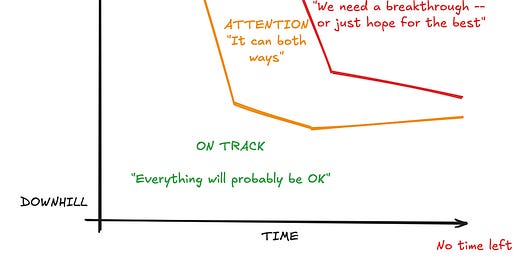Speaking about choices we can make, when it comes to help embrace more of the probabilistic nature of what we do (in software and knowledge related kind of work), another major one is how we balance risks by how we go about choosing what we’ll do in the first place.
You (may) know my personal view on this – value is, ultimately, about risk (or to be more precise in language, and less “marketing-like”, we will tend to optimize for value better by thinking about it with a risk management lens). I even shared earlier an insight on how you can practically do it in the context of managing stakeholder’s expectations, where basically we communicate in a more nuanced fashion on commitments: what we are are pretty confident we can achieve and what we might get to next if things go sufficiently our way in the period.
Now, there’s a factor that can influence that prospect which I haven’t focused on until now… and so it enters our metaphor…
First of all, giving credit where due, I learned about it from the Shape Up method by Ryan Singer, as a powerful yet simple way to communicate how a team assess to be in the track towards finishing some piece of work:
Source: https://basecamp.com/shapeup/3.4-chapter-13#work-is-like-a-hill
This uphill vs downhill metaphor, like that put in a timeline, captures the dynamic aspect of going through work. And that alone can go a long way in helping communicate as well as get a sense whether we will make it given the remaining timeline.
If we were to map that dynamic aspect out, as we progress over time for the given period our piece of work has been prioritized to executed on, we could think of plotting areas to help assess that implied risk question as illustrated below. To put in other words, the more time has passed and we are still going “uphill”, the less time we have to adapt for emerging circumstances.
That obviously is a very valid and enriching conversation take to explore, with a simple yet powerfull metaphor, I’m not only totally onboard with it: I’m an advocate. But I also believe there’s more of a static aspect related to that which can be useful earlier on, as we are going about making choices of what to select and prioritize next.
By the way, Ryan, in his Shape Up method, does explore many related aspects of how to place your bets (to use their language) when making those choices of what to move to execution. He talks about sizing the appetite to go after a solution, also about mix and matching bigger with smaller projects, and stuff like that.
I also personally like to think from that “uphill vs dowhill” perspective as a snapshot, a static essential nature of that specific piece of work upfront. In other words, work will tend to lean towards one of those sides:
Uphill: mostly unknow, we haven’t done much before stuff that we can make a parallel to, or there are too many uncertainties and dependencies on our way (from what we know today).
Dowhill: mostly known, “paved road” kind of work, we have done plenty of either similar or stuff we can make a parallel to, and there are not that many uncertainties and dependencies on our way (from what we know today).
Reality may be that many things will be nuanced, in which case I recommend essentially common sense. You either convince yourselves (as a team or group of people dealign with the work) one way or the other, or if it’s too difficult to fairly assess, maybe you go with “uphill” first or figure out what you could do shortly to better assess.
Putting to practice
While assessing each piece work under consideration as either way (uphill or downhill) may have some value, the real power I am alluding to is to make use of it as practical way to balance your choices. That may even mean to deliberately, in the moment and context, tweak whatever way you may have used to stack-rank your options, for instance.
It’s interesting to also realize that there can be yet another dynamic aspect at play (besides the “uphill / downhill” pattern that any piece of work can go through, as the Shape Up method suggests) which is how we go about pulling work in case we are done with something else on the initial set we are pretty confident on finishing first. Which is to say that we can once again take the perspective of balancing our choices to reason in context (and assuming that’s still a reasonable think to do, we still have both capacity and time available) , e.g.;
Should Option 2 (riskier) be finished first, then pulling up the first next in order, Option 3 (also riskier), may make sense, but probably not if Option 1 or 4 (less risk) are finished first – in that case, probably pulling Option 5 (less risk) makes most sense.
I hope you see the point here. We can make our lives simple(r) by being more mindful about the risks we take as an early assessment. But that’s also a matter of context and moment, ultimately, to decide what to take next. In short, always choose wisely…
By Rodrigo Sperb, feel free to connect, I'm happy to engage and interact. I’m passionate about leading to achieve better outcomes with better ways of working. How can I help you?





